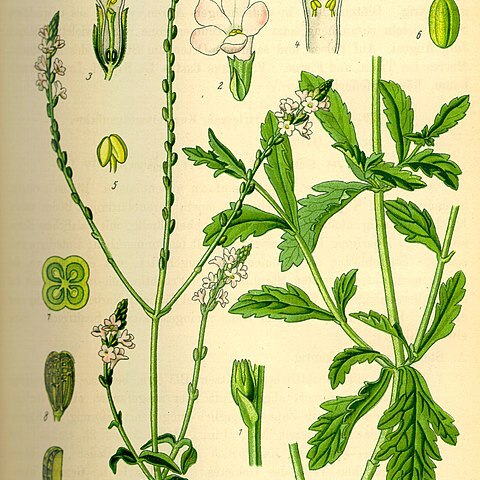Herbs, sometimes slightly woody at base, or subshrubs, open or decumbent, matted or tufted, rarely glabrous; branches quadrangular or almost so. Leaves mostly decussate, rarely whorled, small, entire or variously incised or pinnatifid. Inflorescence usually much branched, sometimes a capitate spike (when young), often elongating after flowering, terminal, rarely axillary, usually densely many-flowered. Flowers solitary in axil of a minute, inconspicuous bract. Calyx usually tubular, unequally and minutely 5-toothed, or only 4-toothed (V. supina); teeth not contorted at maturity. Corolla funneliform; tube straight or slightly curved; lobes 5, slightly unequal and spreading. Stamens 4, didynamous, included in corolla tube. Ovary with 2 carpels, each carpel 2-locular, hence ovary appearing 4-locular with 1 ovule per loculus; style less than 3 times length of ovary. Fruit dry, readily separating at maturity into 4, 1-seeded mericarps; pericarp not extended basally.
Annual or perennial herbs or subshrubs. Leaves opposite or sometimes in whorls of 3, simple and dentate or deeply divided, rarely entire. Flowers in simple spikes or panicles of spikes, often dense and compact or more elongate and lax, bracteate, terminal. Calyx tubular, distinctly and ± unequally (4–)5-toothed, 5-ribbed. Corolla funnel-shaped or hypocrateriform; tube straight or ± curved, ± pubescent within; limb 5-lobed, ± spreading, feebly to distincdy 2-lipped. Stamens (2–)4(–5), included, usually inserted near the middle of the tube but sometimes higher, didynamous. Ovary entire or 4-lobed, 4-locular with a single ovule in each locule; style slender but ± short; stigma unequally 2-lobed. Fruit splitting into 4 nutlets at maturity, enveloped in the persistent calyx. Nutlets with inner face often scabridulous or granulate.
Annual or perennial, taprooted or rhizomatous herbs or subshrubs, unarmed, usually hairy. Lvs usually opposite, rarely in whorls of 3 or alternate, usually toothed or lobed. Infl. usually of 1 or more terminal spikes, these often corymbosely or paniculately arranged; fls sessile or subsessile, usually rather small, bracteate. Calyx tubular, 5-ribbed and unequally 5-toothed, ± accrescent. Corolla salverform; tube straight or curved, usually > calyx; limb 5-lobed and ± 2-lipped, the lobes obtuse or emarginate. Stamens 4, didynamous, included. Style included. Ovary 4-celled; ovules 1 to each cell. Fr. dry, separating into 4 nutlets.
Fls in spikes (or heads) ending the stem and branches; cal tubular, 5-angled and unequally 5-toothed, persistent, scarcely changing in fr; cor salverform or funnelform, the tube straight or curved, the limb flat, weakly 2-lipped, with 5 obtuse or emarginate lobes; stamens 4, paired, included; anther-connective often with a glandular appendage; style terminal, shortly 2-lobed, only one lobe stigmatic; ovary with 4 uniovulate chambers, often rather shallowly 4-lobed, separating at maturity into 4 nutlets, these often ridged or reticulate; ours herbs. (Glandularia) 250, mostly New World.
Herbs or subshrubs, annual or perennial. Branches 4-veined. Leaves opposite, sessile, dentate, lobed, or pinnatifid. Spikes usually terminal, simple or branched; bracts small. Flowers alternate, nearly zygomorphic. Calyx membranous, 5-dentate. Corolla with a distinct tube; lobes 5, unequal, spreading. Stamens 4, fertile, didynamous, inserted at middle of corolla tube, included; anthers ovate. Ovary 4-locular; ovules erect, 1 per locule. Capsules dry, included in calyx, dehiscing into 4 1-seeded pyrenes.
Corolla funnel-shaped or hypocrateriform; tube straight or curved, cylindric or widening slightly towards the apex, usually villous within particularly at the mouth and about the insertion of the filaments; limb spreading, oblique, weakly 2-lipped, with unequal obtuse lobes, rounded or emarginate at the apex.
Ovary 2-carpellate, entire or slightly lobed at the apex, 4-locular at anthesis, each locule l-ovulate; ovules anatropous, erect, attached laterally at or near the base; style usually equalling the stamens, divided at the apex into a short, stigmatic anterior lobe and an acute horny sterile posterior tooth.
Stamens 4, included, didynamous; filaments inserted about or above the middle of the corolla tube; anthers ovate, with parallel or diverging thecae without appendages, or the connectives of upper 2 stamens each provided with a clavate or glanduliform appendage.
Fruit a schizocarp, enclosed within the persistent calyx, separating when ripe into four 1-seeded mericarps; mericarps linear or oblong, with dry pericarp, longitudinally ribbed with a raised reticulation toward the apex.
Inflorescences spicate with the spikes terminal, sometimes axillary, simple or corymbosely or paniculately arranged; spikes densely crowded, or elongate with distant flowers.
Calyx tubular, 5-angled and ribbed on the angles, unequally 5-toothed, ± dilated at the base in the fruiting stage and then ventricose, eventually splitting.
Leaves opposite and usually decussate, rarely 3-whorled or alternate, dentate, or often incised or variously lobed or partite, rarely entire.
Flowers small or medium-sized, sessile, each solitary in the axil of a narrow bract.
Stems 4-angled, erect ascending or procumbent, glabrous or hairy.
Annual or perennial herbs, small shrubs, woody climbers or trees.
Seeds oblong; endosperm lacking or scanty.


